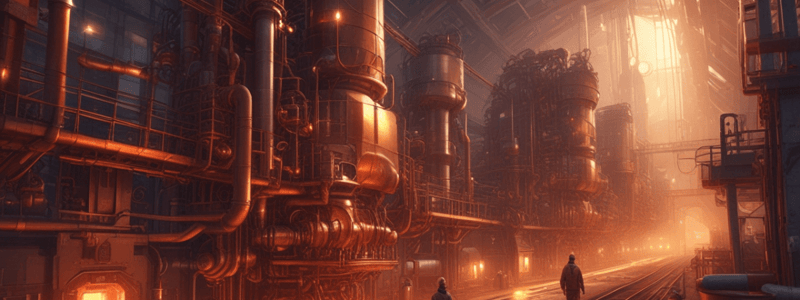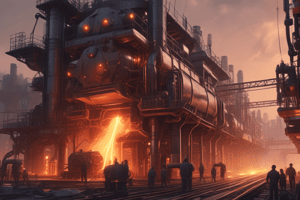Podcast
Questions and Answers
What is the primary hardening element in carbon tool steel?
What is the primary hardening element in carbon tool steel?
- Iron
- Martensite
- Carbon (correct)
- Pearlite carbon
At what temperature does the pearlite carbon change to martensite or hardening carbon?
At what temperature does the pearlite carbon change to martensite or hardening carbon?
- At the critical point
- At the decalescence point
- At room temperature
- At a certain temperature during heating (correct)
What happens to the steel when it is heated to the decalescence point?
What happens to the steel when it is heated to the decalescence point?
- It changes color
- It absorbs heat without appreciably rising in temperature (correct)
- It cools rapidly
- It becomes brittle
What is the purpose of tempering or stress relieving hardened materials?
What is the purpose of tempering or stress relieving hardened materials?
What is the difference between full annealing and normalizing heat treatment?
What is the difference between full annealing and normalizing heat treatment?
What is the result of the hardening process?
What is the result of the hardening process?
What is the primary goal of heat treatment of steel?
What is the primary goal of heat treatment of steel?
Why is annealing done to steel?
Why is annealing done to steel?
What is a prerequisite for hardening steel?
What is a prerequisite for hardening steel?
What is the result of softening steel?
What is the result of softening steel?
What is the purpose of heat treatment in manufacturing?
What is the purpose of heat treatment in manufacturing?
Why are steels particularly suitable for heat treatment?
Why are steels particularly suitable for heat treatment?
What is the primary goal of heat treatment in materials?
What is the primary goal of heat treatment in materials?
What is the purpose of solution annealing?
What is the purpose of solution annealing?
What is the purpose of thermo-mechanical treatments in heat treatment?
What is the purpose of thermo-mechanical treatments in heat treatment?
What is the result of quenching in heat treatment?
What is the result of quenching in heat treatment?
What is the result of stress relieving heat treatment?
What is the result of stress relieving heat treatment?
What is the goal of austempering?
What is the goal of austempering?
What is the purpose of normalizing in heat treatment?
What is the purpose of normalizing in heat treatment?
What is the purpose of tempering in heat treatment?
What is the purpose of tempering in heat treatment?
What is the difference between austempering and martempering?
What is the difference between austempering and martempering?
What is the advantage of austempering over other heat treatments?
What is the advantage of austempering over other heat treatments?
What is the result of spheroidising in heat treatment?
What is the result of spheroidising in heat treatment?
What is the final step in the austempering process?
What is the final step in the austempering process?
What is represented by the CCT diagram?
What is represented by the CCT diagram?
What is the primary advantage of CCT diagrams over TTT diagrams?
What is the primary advantage of CCT diagrams over TTT diagrams?
What is hardenability?
What is hardenability?
What is the Jominy end-quench test used for?
What is the Jominy end-quench test used for?
What is the effect of fast cooling on the material?
What is the effect of fast cooling on the material?
What is precipitation hardening also known as?
What is precipitation hardening also known as?
What is the purpose of the solution heat treatment in precipitation hardening?
What is the purpose of the solution heat treatment in precipitation hardening?
Why is the supersaturated solution stable at low temperatures?
Why is the supersaturated solution stable at low temperatures?
What happens if the precipitation heat treatment is continued for a very long time?
What happens if the precipitation heat treatment is continued for a very long time?
What is the role of heat capacity in determining the cooling rate?
What is the role of heat capacity in determining the cooling rate?
What is the result of embrittlement during tempering?
What is the result of embrittlement during tempering?
What is the purpose of recrystallization in metals processing?
What is the purpose of recrystallization in metals processing?
What is the main difference between TTT and CCT diagrams?
What is the main difference between TTT and CCT diagrams?
What is the result of austempering?
What is the result of austempering?
What is the advantage of using CCT diagrams in engineering applications?
What is the advantage of using CCT diagrams in engineering applications?
What is the result of continuous cooling in CCT diagrams?
What is the result of continuous cooling in CCT diagrams?
Flashcards are hidden until you start studying
Study Notes
Heat Treatment of Steel
- Heat treatment is the controlled heating and cooling of metals to alter their physical and mechanical properties without changing the product shape.
- Steels are particularly suitable for heat treatment, since they respond well to heat treatment and the commercial use of steels exceeds that of any other material.
Reasons for Heat Treatment
- Softening: to reduce strength or hardness, remove residual stresses, improve toughness, restore ductility, refine grain size, or change the electromagnetic properties of the steel.
- Hardening: to increase the strength and wear properties.
- Material Modification: to modify properties of materials in addition to hardening and softening, such as stress relieving, cryogenic treatment, or spring aging.
Heat Treatment Processes
- Annealing: heating the material above the critical temperature, holding long enough for transformation to occur, and slow cooling.
- Normalizing: heating a steel above the critical temperature, holding for a period of time long enough for transformation to occur, and air cooling.
- Quenching: heating the material to a suitable temperature and then quenching in water or oil to harden to full hardness.
- Tempering: reheating the steel at a relatively low temperature to develop the required combination of hardness, strength, and toughness or to relieve the brittleness of fully hardened steels.
Critical Temperatures
- Decalescence point: the temperature at which steel continues to absorb heat without appreciably rising in temperature.
- Critical point: the temperature at which the steel actually increases in temperature, although its surroundings may be colder.
Hardening
- The use of this treatment will result in an improvement of the mechanical properties, as well as an increase in the level of hardness, producing a tougher, more durable item.
- Alloys may be air cooled, or cooled by quenching in oil, water, or another liquid, depending upon the amount of alloying elements in the material.
Austempering and Martempering
- Austempering: a technique used to form pure bainite, a transitional microstructure found between pearlite and martensite.
- Martempering: similar to austempering, but the goal is to create martensite rather than bainite.
Embrittlement
- Occurs during tempering when, through a specific temperature range, the steel experiences an increase in hardness and a reduction in ductility.
- Two types: tempered martensite embrittlement (TME) or one-step embrittlement, and temper embrittlement (TE) or two-step embrittlement.
Recrystallization
- A process by which deformed grains are replaced by a new set of defects-free grains that nucleate and grow until the original grains have been entirely consumed.
- Usually accompanied by a reduction in the strength and hardness of a material and a simultaneous increase in the ductility.
Time-Temperature Transformation (TTT) and Continuous Cooling Transformation (CCT) Diagrams
- TTT diagrams: measure the rate of transformation at a constant temperature.
- CCT diagrams: measure the extent of transformation as a function of time for a continuously decreasing temperature.
- CCT diagrams are more practical than TTT diagrams as most of the processes employ continuous cooling rather than isothermal transformation.
Hardenability
- The ability of the material to be hardened by forming martensite.
- Measured by the Jominy end-quench test.
- Hardenability is then given as the dependence of hardness on distance from the quenched end.### Cooling and Thermal Gradients
- Fast cooling of a metal piece can cause warping and crack formation due to large thermal gradients.
- The shape and size of the piece, along with its heat capacity and heat conductivity, influence the cooling rate for different parts of the metal.
Heat Capacity and Heat Conductivity
- Heat capacity is the energy content of a heated mass that needs to be removed for cooling.
- Heat conductivity measures how fast energy is transported to the colder regions of the piece.
Precipitation Hardening
- Precipitation hardening, also known as age hardening, enhances hardening by forming extremely small precipitates that hinder dislocation motion.
- Precipitates form when the solubility limit is exceeded.
Steps to Achieve Precipitation Hardening
- Solution heat treatment: dissolve all solute atoms to form a single-phase solution.
- Rapid cooling across the solvus line to exceed the solubility limit, resulting in a supersaturated solid solution.
- Precipitation heat treatment: heat the supersaturated solution to an intermediate temperature to induce precipitation and keep it there for some time (aging).
Overaging
- If the precipitation hardening process is continued for a very long time, the hardness eventually decreases, a phenomenon known as overaging.
Studying That Suits You
Use AI to generate personalized quizzes and flashcards to suit your learning preferences.




